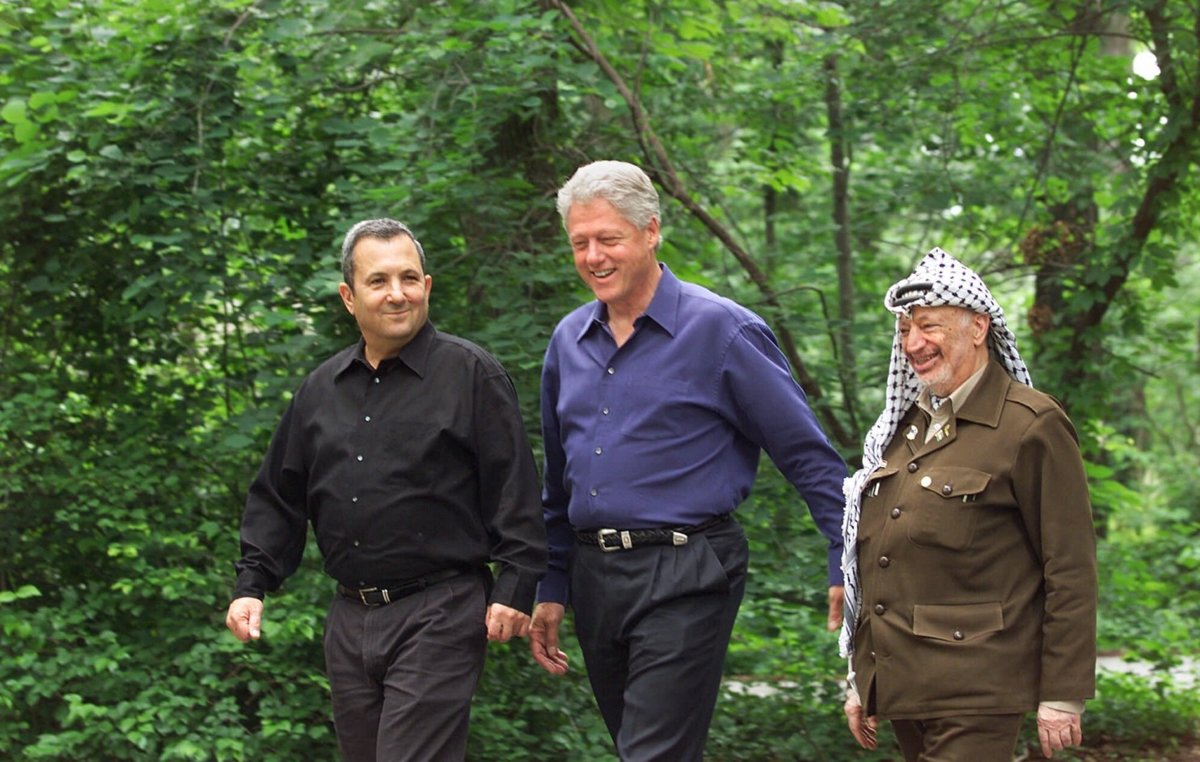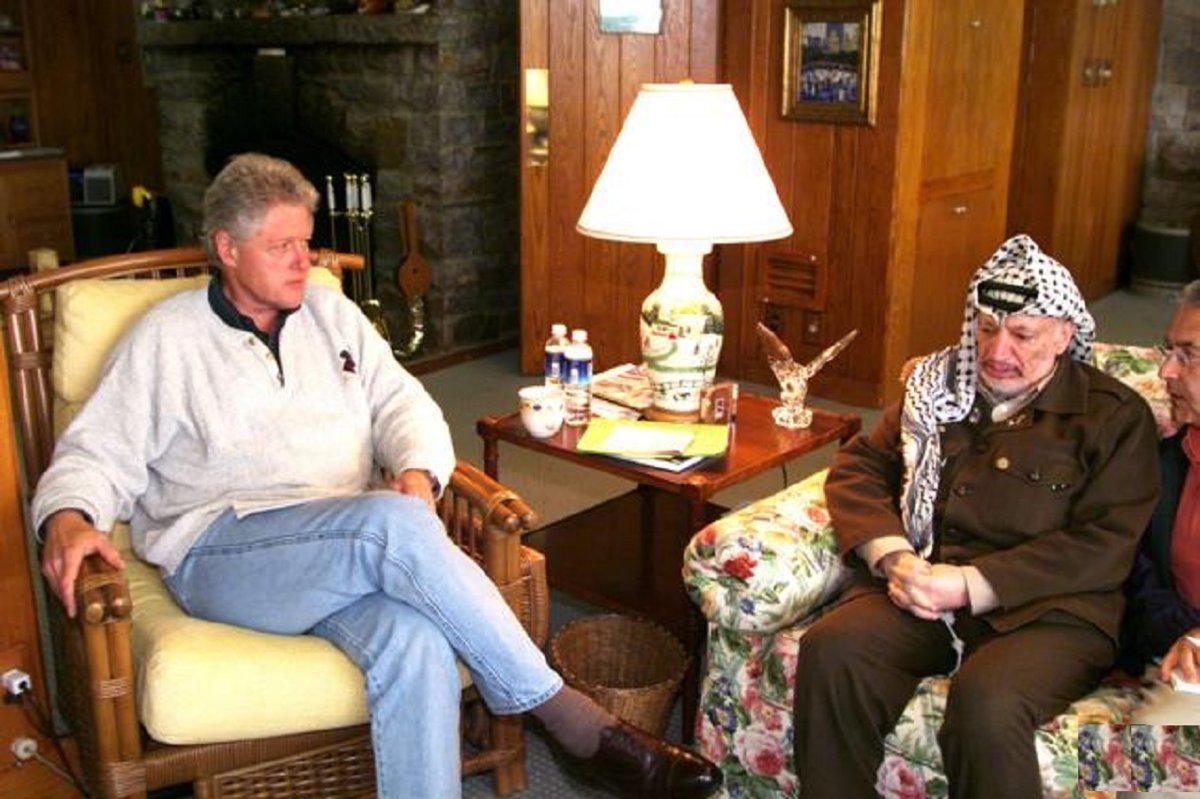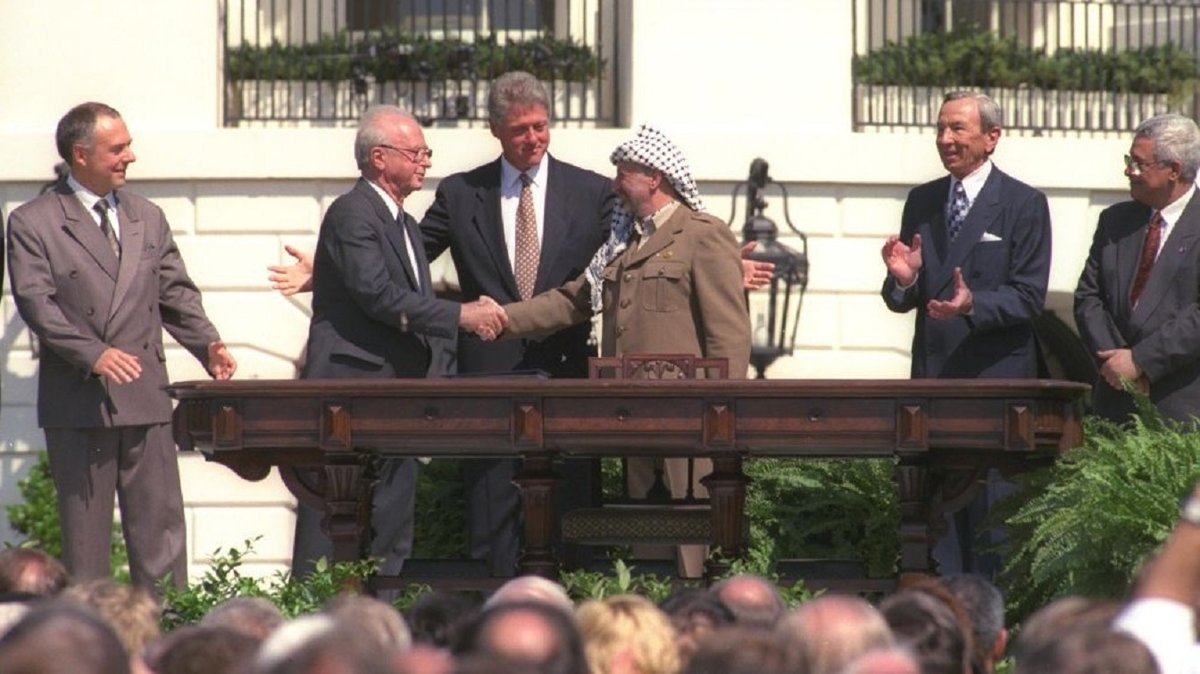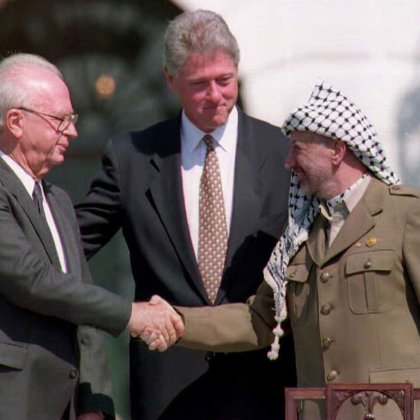THE ARAB - ISRAEL PEACE PROCESS AT CAMP DAVID BETWEEN AMERICAN PRESIDENT BILL CLINTON,PALESTINIAN AUTHORITY CHAIRMAN YASSER ARAFAT AND ISRAELI PRIME MINISTER EHUD BARAK .THE PALESTINIANS GAINED ACCEPTANCE AS AN INDEPENDENT NEGOTIATING PARTNER WITH ISRAEL.THE OSLO PROCESS,WHICH SECURED THAT ACCEPTANCE ,DID NOT BRING ABOUT A PERMANENT SETTLEMENT OF THE ISRAELI - PALESTINIAN CONFLICT.
 The Camp David summit in pursuit of a Middle East peace settlement
collapse. The president has concluded that the two sides
are not able to reach an agreement at this time.President Bill Clinton was returning to Washington to make the
announcement. It had become clear earlier in the day that no serious
headway was in sight despite an offer by Israeli Prime Minister Ehud
Barak to Palestinian leader Yasser Arafat to recognize some sort of
Palestinian sovereignty in east Jerusalem.
The Camp David summit in pursuit of a Middle East peace settlement
collapse. The president has concluded that the two sides
are not able to reach an agreement at this time.President Bill Clinton was returning to Washington to make the
announcement. It had become clear earlier in the day that no serious
headway was in sight despite an offer by Israeli Prime Minister Ehud
Barak to Palestinian leader Yasser Arafat to recognize some sort of
Palestinian sovereignty in east Jerusalem.
The Camp David meeting ended without agreement on July 25, 2000. At this point, according to conventional wisdom, the Palestinian leader’s “response to the Camp David proposals was not a counteroffer but an assault Arafat figured he could push one more time to get one more batch of concessions. The talks collapsed. Violence erupted again. He “used the uprising to obtain through violence what he couldn’t get at the Camp David bargaining table.Because of the geographic placement of Israel’s proposed West Bank annexations, Palestinians living in their new “independent state” would be forced to cross Israeli territory every time they traveled or shipped goods from one section of the West Bank to another, and Israel could close those routes at will. Israel would also retain a network of so-called “bypass roads” that would crisscross the Palestinian state while remaining sovereign Israeli territory, further dividing the West Bank.Israel was also to have kept “security control” for an indefinite period of time over the Jordan Valley, the strip of territory that forms the border between the West Bank and neighboring Jordan. Palestine would not have free access to its own international borders with Jordan and Egypt–putting Palestinian trade, and therefore its economy, at the mercy of the Israeli military.American President Bill Clinton, Israeli Prime Minister Ehud Barak and President Yasser Arafat of the PLO/PNA met at Camp David in 2000 in order to negotiate a final settlement of the Palestine-Israel conflict based on the Israel/PLO Oslo Accords. The Palestinians went to Camp David expecting genuine negotiations about the end of the conflict and envisaged it as the ‘climax’ of the Oslo negotiations, as embedded in the Oslo Agreement. During an interim period of five to ten years, during which Israel would partially withdraw from the Occupied Territories, the essentials of the conflict would be negotiated in a final phase.Peace Efforts and the Right of Return,the right of return of Palestinian refugees has always been a crucial issue in all peace efforts. The failure of Israel and the Western powers to appreciate the importance of this right for Palestinians has been one of the main causes of the failure of all peace negotiations conducted to date. The issue of the right to return and compensation was addressed in a series of peace plans, all of which were unsuccessful.Another unofficial agreement, Ami Ayalon, and a former PLO representative in Jerusalem, Sari Nusseibeh. This plan envisaged a return to the 1967 lines and an open city of Jerusalem.Regarding the Palestinian refugees, the plan started by ‘recognizing the suffering and the plight of the Palestinian refugees’ without mentioning who was responsible for these or for the decades of suffering. Return should only be possible to the nascent State of Palestine that would be created according to the plan. The plan also proposed that the international community, Israel, and the Palestinian State should contribute to an international fund to compensate the refugees.Concerning the claim to a right of return, the plan affirmed the right of Palestinian refugees to return only to the State of Palestine. The international community should then offer compensation towards improving the lives of those refugees willing to remain in their present country of residence, or who wished to emigrate to third-party countries.In the aftermath of the Madrid Conference in 1991, diplomatic efforts were made to initiate peace negotiations between Israel and the Arab countries. As a result, a bilateral Peace Treaty was signed in October 1994 between Jordan and Israel. Article 8 of the treaty concerned refugees and displaced persons and started by recognizing the massive human problems caused to both parties in the conflict. The parties agreed that the problems of displaced persons should be resolved in appropriate forums, in accordance with international law.In regard to refugees, negotiations would be continued in ‘the framework of the Multilateral Working Group on Refugees’ and ‘through the implementation of agreed United Nations programmes and other agreed international economic programmes concerning refugees and displaced persons, including assistance to their settlement’. In this peace treaty, as in others, Israel obtained recognition, peace and security while the resolving of the refugee problem was postponed to later talks. This peace treaty was interesting because of the events which followed the accords concerning the compensation of displaced Palestinians who became Jordanian citizens in 1949.Immediately after signing the treaty, Jordan proposed that Israel should pay compensation to Jordanian citizens who owned land in Palestine before the creation of the State of Israel in 1948. The Jordanian logic was that with the signing of the treaty, Jordanian citizens could no longer be considered as enemies of Israel and therefore were no longer subject to the ‘absentees’ laws and regulations enacted by Israel to confiscate their properties after 1948.The Israeli parliament was not willing to pay this compensation; it subsequently ratified the peace treaty yet at the same time passed a law stating that ‘Jordanian citizens who had been declared absentees prior to the peace treaty would remain classified as such’ after its ratification. The protest of the Jordanian government against this discriminating law that violated Article 11.bis of the treaty meant to abolish discriminatory legislation in both countries, did not bring any change on the issue. According to Fischbach, Israel never sent an official reply to the Jordanian request.This account is one of the most tenacious myths of the conflict. Its implications are obvious: There is nothing Israel can do to make peace with its Palestinian neighbors. The Israeli army’s increasingly deadly attacks, in this version, can be seen purely as self-defense against Palestinian aggression that is motivated by little more than blind hatred.To understand what actually happened at Camp David, it’s necessary to know that for many years the PLO has officially called for a two-state solution in which Israel would keep the 78 percent of the Palestine Mandate (as Britain’s protectorate was called) that it has controlled since 1948, and a Palestinian state would be formed on the remaining 22 percent that Israel has occupied since the 1967 war (the West Bank, the Gaza Strip and East Jerusalem). Israel would withdraw completely from those lands, return to the pre-1967 borders and a resolution to the problem of the Palestinian refugees who were forced to flee their homes in 1948 would be negotiated between the two sides. Then, in exchange, the Palestinians would agree to recognize Israel.
 24 JULY 2000 - CAMP DAVID, MARYLAND: President Bill Clinton meets with Palestinian Chairman Yasser Arafat July 24 at Camp David. Joining them is Gamal Helal.The Oslo process – started between Israel and the Palestinians – clearly failed to bring a resolution to the conflict, and did not result in a peaceful coexistence between Israelis and Palestinians.The nearly 1,500 Israeli casualties and many more thousands of wounded during this period by Palestinian terrorist and rocket attacks testify to this failure.
24 JULY 2000 - CAMP DAVID, MARYLAND: President Bill Clinton meets with Palestinian Chairman Yasser Arafat July 24 at Camp David. Joining them is Gamal Helal.The Oslo process – started between Israel and the Palestinians – clearly failed to bring a resolution to the conflict, and did not result in a peaceful coexistence between Israelis and Palestinians.The nearly 1,500 Israeli casualties and many more thousands of wounded during this period by Palestinian terrorist and rocket attacks testify to this failure.In 1993, Chairman of the Palestinian Liberation Organisation (PLO) Yasser Arafat and Israeli Prime Minister Yitzhak Rabin, shook hands after signing the Oslo peace accords, in what would become an iconic moment in the history of the Israeli-Palestinian conflict. Yet 25 years later, the promise of peace remains unfulfilled and the struggle for a Palestinian homeland continues, with the failure of Oslo increasingly acknowledged.The famous handshake marked the final stage of months of secret peace talks conducted in Oslo, Norway between the Israeli government and leading Palestinian faction Fatah. Under the terms of the deal, Israel agreed to withdraw its troops from Gaza Strip and the occupied West Bank by April 1994. Elections were to be held in the territories to allow the Palestinians some form of autonomy and self-governance. In return, Chairman Arafat signed two letters renouncing violence and officially recognising 78 per cent of historical Palestine as Israel; Tel Aviv, in turn, withdrew their recognition of the PLO as a terrorist organisation, instead affirming them as the legitimate representative of the Palestinian people.The issue of Jerusalem, settlements, Palestinian refugees, and the question of borders were among the responsibilities that would remain with Israel. The accords were also to preserve Israel’s exclusive control of the borders, the airspace and of Gaza’s waters.The peace deal was due to be signed in Washington under the ushers of the administration of the US President Bill Clinton.On 13 September 1993, Clinton introduced the two leaders, alongside other state officials and former US presidents Jimmy Carter and George Bush, to the crowd of invited guests in front of the White House. The two national heads did not sign the declaration themselves. Instead, Israeli Foreign Minister Shimon Peres and Palestinian counterpart Mahmoud Abbas did the signing to rapturous applause.The two statesmen then turned to face one another, with President Clinton’s arms outstretched between them, before Arafat extended his hand first towards Rabin. The handshake prompted a standing ovation and cheers from the audience. Arafat then proceeded to shake hands with Peres and the other Israeli officials on stage, a move not reciprocated by Rabin.In speeches delivered after the signing, Prime Minister Rabin then addressed the crowd of reporters and officials: “We who have fought against you the Palestinians, we say to you today in a loud and clear voice, enough of blood and tears, enough,” he proclaimed.“The difficult decision we reached together was one that required great courage,” said Arafat in his subsequent speech. “Our two peoples are awaiting today this historic hope, and they want to give peace a real chance.The handshake made front page headlines across the world, hailed as a historic triumph of peace over conflict by media outlets and politicians. The signing of the Oslo Accords brought an end to the First Intifada, which had seen hundreds of Palestinians killed and thousands injured after Israel responded violently to the popular uprisings across the occupied territories.In 1994 Arafat and Rabin received a Nobel Peace Prize for their participation in the accords. Arafat was also elected president of the newly established Palestinian Authority (PA) the same year, which paved the way for the signing of Oslo II in 1995, which affirmed the establishment of a Palestinian interim self-government. Neither accord promised future Palestinian statehood.Israeli military withdrawal from the West Bank has never taken place. Israel has planted hundreds of military checkpoints, expanded illegal settlements that have seized large swathes of Palestinian farms and residential areas, built an illegal separation wall and evicted Palestinians from their homes and handed them to Israeli settlers.The Israeli siege on Gaza, now in its 11th year, has made the Strip “unliveable” three years ahead of the UN’s dark prediction. Gaza was subjected to four major Israeli offensives between 2006 and 2014 that claimed the lives of thousands of Palestinian civilians, wounded tens of thousands others, devastated infrastructure, paralysed hospitals, destroyed schools and universities.The parties and sponsors of Oslo agreed to implement interim self-governance arrangements and a framework to facilitate the negotiations for the final status issues by the end of 1999. However, two and a half decades later, no progress has been made.While official efforts failed, an informal agreement was announced in December 2003 by Israeli and Palestinian personalities – Yossi Beilin, one of the architects of Oslo, on the Israeli side, and former Palestinian Information Minister Yasser Abed Rabbo on the other. The Geneva Accord had no official status. A significant aspect of the plan was that it reversed the concept of the road map and gave priority to reaching agreement on important issues as a condition for security and peace instead of delaying these issues until ‘final talks’.A key reason for rejecting the Geneva Accord was that it proposed that Palestinians should effectively give up their ‘right of return’. In Article 7 of the draft plan both parties had to recognize Resolution 194 (III) as well as the Arab Peace Initiative as the basis for resolving the refugee issue. However, the working of this proposal restricted the Palestinians’ rights to ‘compensations for their refugeehood and for loss of property’. States that hosted Palestinians should also be financially rewarded: they had a right to remuneration. As to the refugees’ choice of their place of residence, this was limited to the state of Palestine-to-be and to third countries.According to the plan, a refugee’s choice to return to Israel should be submitted to ‘the sovereign discretion of Israel’. Priority should be given to the Palestinian refugee population in Lebanon The plan encountered strong opposition from Palestinian refugees.
 PLO Chairman Yasser Arafat shakes hands with Israeli Prime Minister Yitzhak Rabin, as U.S. President Bill Clinton watches in 1993.U.S. President Bill Clinton stands between PLO leader Yasser Arafat and Israeli Prime Minister Yitzahk Rabin as they shake hands at the White House in Washington D.C. The prime minister was shot in the back by far-right Jewish Israeli Yigal Amir as he was leaving a peace rally in Tel Aviv on November 4, 1995. He was pronounced dead a short time later at the nearby Ichilov hospital. The plaza where he was shot, formerly known as Kings of Israel Square, is now called Rabin Square.
PLO Chairman Yasser Arafat shakes hands with Israeli Prime Minister Yitzhak Rabin, as U.S. President Bill Clinton watches in 1993.U.S. President Bill Clinton stands between PLO leader Yasser Arafat and Israeli Prime Minister Yitzahk Rabin as they shake hands at the White House in Washington D.C. The prime minister was shot in the back by far-right Jewish Israeli Yigal Amir as he was leaving a peace rally in Tel Aviv on November 4, 1995. He was pronounced dead a short time later at the nearby Ichilov hospital. The plaza where he was shot, formerly known as Kings of Israel Square, is now called Rabin Square.
